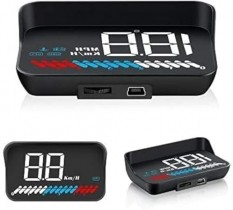Experiencing a flashing ABS light after installing a new Obd2 Port Speedometer in your car? You’re not alone, and thankfully, there’s a straightforward fix that many DIYers can handle. This guide will walk you through troubleshooting and resolving this common issue, ensuring your new speedometer works flawlessly without triggering warning lights.
Many modern car enthusiasts are drawn to Head-Up Display (HUD) speedometers that conveniently project speed directly onto the windshield. These devices, often powered via the OBD2 port, offer a sleek and modern alternative to traditional dashboards. Like many, after getting a 2001 Toyota Tundra, I was eager to install one of these gadgets to enhance my driving experience. I opted for an iKiKin M7 Dual Mode Windshield Projector Car HUD Display, readily available on Amazon, hoping for a simple plug-and-play setup.
However, upon starting the Tundra after plugging in the OBD2 speedometer, an unexpected problem arose: the ABS (Anti-lock Braking System) light began to flash. This immediately signaled a conflict or error. My first step was to disconnect the new speedometer to ensure it was indeed the cause. Upon unplugging the device, the ABS light ceased flashing, confirming the OBD2 speedometer as the source of the issue.
The OBD2 Pin Solution for ABS Light Problems
After some investigation, it turns out this issue is related to a specific pin in the OBD2 connector that the speedometer uses. The solution? Isolating or removing the problematic pin on the speedometer’s connector. In my case, the culprit was pin 11. By carefully removing pin 11 from the speedometer’s OBD2 connector (not the vehicle’s OBD2 port!), the ABS light issue was completely resolved.
Important Note: Before you start removing pins, it’s crucial to identify the exact pin causing the conflict in your specific setup. While pin 11 worked for me, it might be pin 9 or 10 in other scenarios. Do not blindly remove pin 11 without testing!
How to Identify the Trouble Pin
Here’s a step-by-step method to safely pinpoint the problematic pin without permanently altering your speedometer’s connector right away:
- Prepare needle-nose pliers: You’ll need these for gently bending the pins.
- Isolate pin 9 initially: Using the pliers, carefully bend pin 9 downwards towards the bottom of the connector housing. This will effectively prevent pin 9 from making contact when plugged in.
- Test: Plug the modified speedometer connector back into your car’s OBD2 port and start the vehicle. Check if the ABS light is still flashing.
- Repeat for pin 10 and 11: If the ABS light remains, unplug the speedometer, straighten pin 9 back to its original position (if you want to reuse it later), and repeat the bending process with pin 10, then test again. If still no fix, repeat for pin 11.
- Identify the culprit: By testing each pin (9, 10, and 11) individually, you can determine which pin is causing the conflict when connected to your vehicle. In my experience, it was pin 11.
- Pin Removal (Once Identified): Once you’ve identified the problematic pin (e.g., pin 11), you can proceed to carefully remove it from the speedometer’s connector using needle-nose pliers. Gently wiggle and pull the pin until it comes out.
Why does this happen?
The likely cause is a minor short circuit or signal conflict created by one of the OBD2 connector pins when the speedometer is plugged in. By removing the specific pin causing this interference, you allow the speedometer to function correctly without triggering the ABS warning system. This is often due to slight variations in how aftermarket devices interact with different vehicle systems.
Conclusion: Enjoy Your OBD2 Speedometer, ABS Light Free
By following these steps, you should be able to resolve the ABS light issue caused by your OBD2 port speedometer. Remember to proceed cautiously when modifying the connector and always test to identify the correct pin before permanent removal. With a little careful troubleshooting, you can enjoy the benefits of your new HUD speedometer without any annoying warning lights. Always prioritize safety and consult a professional mechanic if you are uncomfortable performing these steps yourself.
